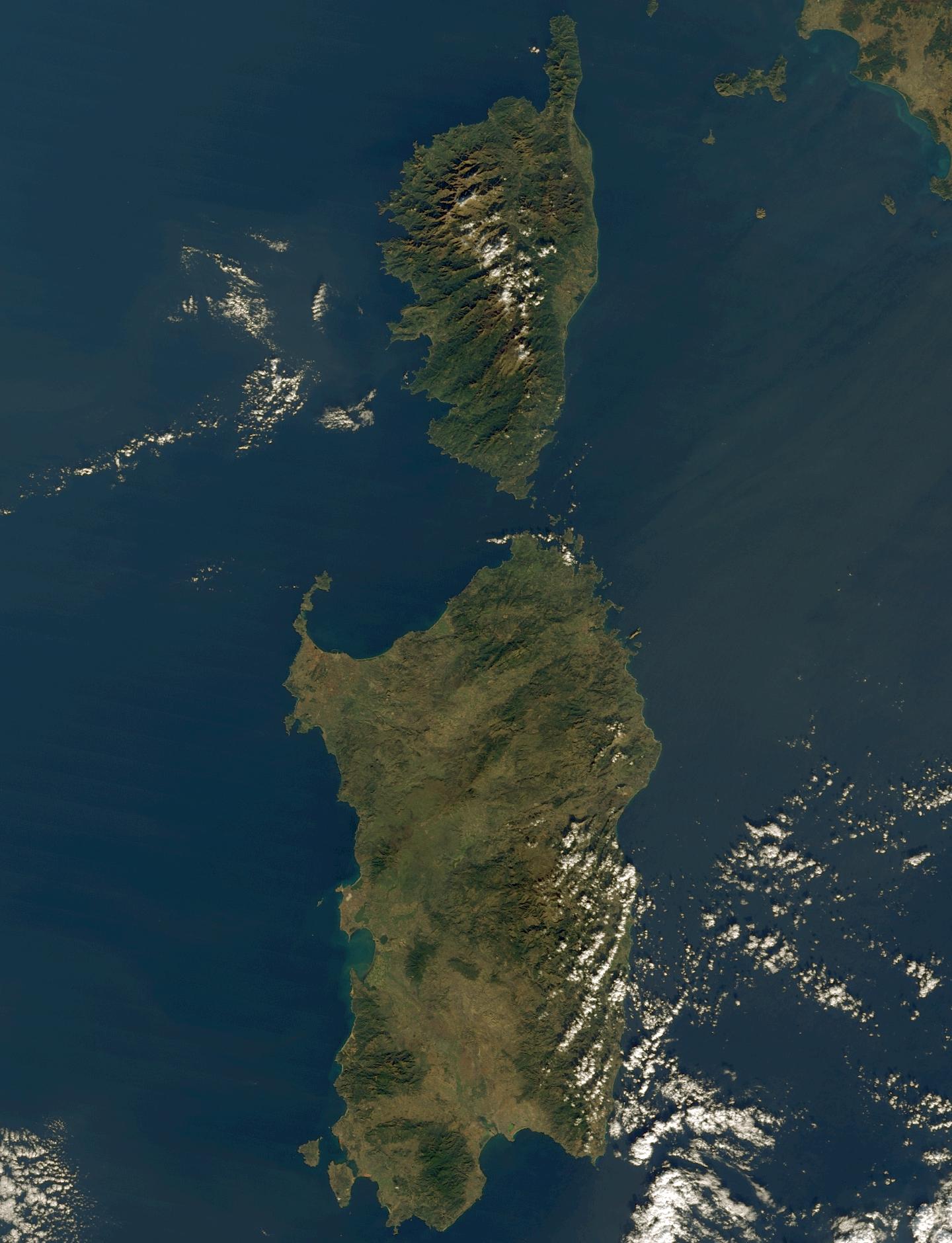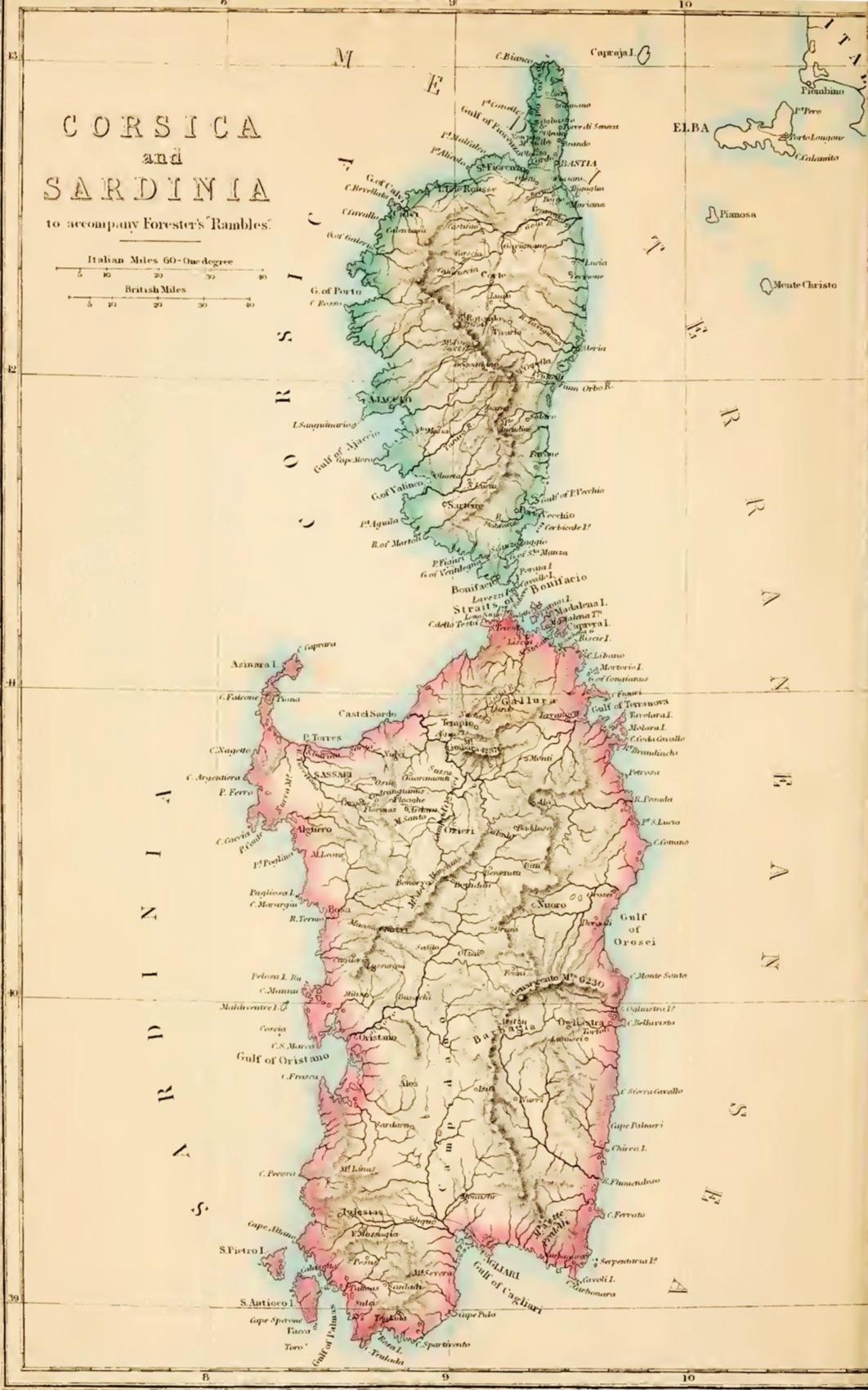Steeped in history and situated in the crossroads of the Mediterranean, the islands of Corsica and Sardinia are enchanting, mountainous islands that have been pivotal since the time of the Roman Empire. Tourists flock to the emerald waters of these islands to find respite from a more chaotic life on the European mainland, but these islands also have a stable population in their own right. Many people find Corsica more rugged and less developed than its larger counterpart Sardinia, which lies a short ferry ride to the south. These two islands are geographically close, yet Corsica is France while Sardinia belongs to Italy. These territorial differences are also reflected linguistically, with cultural differences as Corsicans tend to speak French or Corsican while Sardinians widely speak Italian. Location, place, movement, region and the interaction between human and environment culminate in a dichotomous land of similarity and difference: Corsica and Sardinia.




Gumley, Liam. NASA. https://earthobservatory.nasa.gov/IOTD/view.php?id=2022

Forestor, Thomas. https://www.gutenberg.org/files/28510/28510-h/28510-h.htm
Once an ancient Roman province, Corsica, and Sardinia share a close location in the Mediterranean sea. The absolute location of Corsica is 42.0396° N, 9.0129° E, and the relative location of Sardinia from Corsica is roughly six miles from Corsica's southernmost tip. The relative location of Corsica is west of the Italian peninsula, north of the island of Sardinia, and southeast of the French mainland. Place refers to a location's physical features, such as landforms, elevation, climate, soil, plant and animal diversity, among other features. The formation of Corsica began 250 million years ago as granite was pushed upward out of the Mediterranean sea, followed by the formation of sedimentary rock 200 million years later. These geological activities have made Corsica the most mountainous Mediterranean island. Whereas Corsica is dominated by steep, rugged mountains, Sardinia is much flatter and larger. Sardinia is the second largest Mediterranean island after Sicily. Corsica is the fourth largest after Cyprus. The highest peak of Corsica is Monte Cinto at 8,878 feet tall. On Sardinia, the highest elevation is found on Punta La Marmora. In terms of location and place, Corsica is more mountainous, with a higher elevation than Sardinia.

Monte Cinto, Corsica
http://www.topopyrenees.com/randonnee-monte-cinto-2706m-gr20-corse/
Punta La Marmora, Sardinia
http://www.summitpost.org/summit-view-punta-la-marmora/57269


People have widely interacted with the biophysical environment in both Corsica and Sardinia. However, Sardinia is more populated and has more infrastructure related to tourism. Sardinia's primary industries are mostly related to livestock. 60% of Sardinia's land is for livestock, 20% to agriculture, and the rest is urban areas and closed forests. Sardinia has a vibrant agricultural sector growing citrus fruit, oats, barley, rice, tomato, olive oil, and artichokes. Corsica has a much less developed economy, which is the least developed in all of Metropolitan France, Thus, tourism is a major industry on Corsica, and accounts for more of the island's respective GDP than on Sardinia. Both Corsicans and Sardinians export cheese, meat, and wine. To read more about the Corsican economy, visit http://www.regions-of-france.com/regions/corsica/economy/. In 2012, the GDP of Corsica was $11.43 billion whereas Sardinia's was $33.6 billion, illustrating the difference in economic power between the two islands. Sardinia's economy is more diversified as it supports a wide array of industries that Corsica does not, such as mining. The mining industry is less profitable than it once was but still supports extensive coal, gold, lead, and zinc mining. Besides primary and secondary industries, Corsica and Sardinia support large tertiary industries, especially in service for the throngs of tourists that visit the islands each year.
Sardinia is the fourth least populated region of Italy, and experiences both a low fertility rate and birth rate. It has the lowest fertility rate in all of Italy. The population of the islands are largely elderly, which accounts for the low birth rates. In 1999, people sixty and older accounted for for 24.9% of the population in Corsica, and thus the death rate is higher than the national average. To read more about Corsica and Sardinia's fertility rates and population demographics, visit https://circabc.europa.eu/webdav/CircaBC/ESTAT/regportraits/Information/fr83_pop.htm. Despite a relatively small population compared to regions on the European mainland, Corsicans and Sardinians still have to get around. Transportation on the two islands are facilitated by roads, trains, and a ferry service. Both islands offer airports, but planes are seldom used for inter-island transport. Sardinia does not have the traditional mainland Italy highway system (autostrade) but it does have a well developed road network that links all parts of the island. Corsica too exhibits widespread roads and the entire island is accessible via automobile. For those who wish alternative transport than car, Sardinia has a railway operated by both TrainItalia and ARST. Compared to Sardinia, Corsica's railway is less developed but still a practical way to get around the island. The portion of railway along Corsica's eastern shore was heavily damaged in WWII and remains out of commission. Most tourists to the islands arrive via ferry from mainland Europe, however a large portion also fly into one of the island's airports. The Corsican port of Bastia saw 2.5 million passengers arrive in 2012.
The islands both differ culturally as well as physically. In Corsica, Italian was the official language until May 9th, 1859, when it was replaced by French. A minority language on the island of Corsica is Corsu, or Corsican, which is related to the Tuscan language. Sardinia has mostly Italian speakers, but also has many inhabitants who speak the native Sardinian language, known as Sardu. Sardu is not an Italian dialect, as it is often mistaken as. Rather, it occupies its own branch of the Romance language family tree. Italian has widely replaced many of the indigenous languages on Sardinia as assimilation programs were in place since 1760. Both Sardinia and Corsica share high literacy rates, with Sardinia's being around 99.5% for people under 65 years of age. Despite these high literacy rates, Sardinia has the second highest rate of school drop-outs in all of Italy.

Dialects of the Corsican Language
https://upload.wikimedia.org/wikipedia/commons/thumb/1/10/Dialetti_corsi.png/200px-Dialetti_corsi.png
Corsica and Sardinia share a similar taste in cuisine, as both islands are close geographically and have similar habitats and climate. Game such as wild boar is popular on Corsica, and both islands depend heavily on dairy-based foods like milk and cheese. Besides dairy, both islands widely consume seafood and river fish. A famous Sardinian food is pane carasau, a flat type of bread native to Sardinia. Sardinia has the highest per capita usage of beer in all of Italy, over twice the national average. Both islands share many of the same culinary qualities, but perhaps Sardinians depend more on food from the ocean as their island is less mountainous and the ocean is more accessible.
Both islands have a nationalist inclination in their politics. In 2003, Corsica held a referendum to abolish the two departments of Corsica, leaving extended powers for a territorial collectivity. The referendum failed, but is evidence of the belief among Corsicans that the island should receive more sovereignty over its own affairs. Sardinia is one of Italy's five autonomous regions, which gives it the power to create its own laws and carry out its own administrative functions. The regional administration of Sardinia is governed by a legislative and executive power and President, who is the chief of executive power. Out of all the NATO installations in Italy, 61% are on Sardinia, making it the most militarized Mediterranean island. To read more about the militarization of Sardinia and some push-back against it visit http://21stcenturywire.com/2016/07/13/natos-military-enslavement-and-contamination-of-sardinia/
NATO bases in Italy
http://21stcenturywire.com/2016/07/13/natos-military-enslavement-and-contamination-of-sardinia/
The total population of Corsica is 322,120 inhabitants, whereas Sardinia has 1,656,003, making Sardinia much more populated than its neighboring island to the north. There are two functional regions comprising Corsica, the departments of Haute-Corse and Corse-du-Sud. Sardinia is divided into four provinces which serve as their own functional regions, and a metropolitan city of Cagliari. Most of the inhabitants of both islands are congregated in the cities of the islands, such as Bastia, Calvi, Ajaccio, and Bonifacio on Corsica and Cagliari on Sardinia. Cagliari is a primate city on Sardinia, as no other city comes close to matching its population size of 431,000 in the metropolitan area. Corsica belongs to the formal region of France, while Sardinia is a part of the formal region of Italy. Although these two islands belong to differing formal regions and speak different languages as a result, they have cultural similarities in their diet of meat, fish, and cheese.
Humans have had a direct impact on the Earth in both Corsica and Sardinia. Tourists flock to these two islands every year, and the influx of people on the island takes its toll on the natural landscape and infrastructure. In Corsica, tourism is concentrated in the areas of Calvi in the north and around Porto-Vecchio and Bonifacio in the south. Tourism on the island of Sardinia has lessened the dependence on coal mining, which was disastrous for the environment. After WWII, larger numbers of tourists began coming to the islands which has stimulated the economy and lessened its dependence on primary and secondary industries that dirty the local environment.
So far, we have compared and contrasted Corsica with its southern counterpart Sardinia. We have touched on each of the five themes of geography: location, place, human-environment interaction, movement, and region. We have discussed features of both islands, such as literacy rates, agriculture and other industry, topography, climate, city primacy, and many other features. Sardinia is the larger, more inhabited cousin of Corsica. They both have many similarities, especially in regard to geography, but contrast culturally and linguistically as they belong to separate states. To discover the differences between Corsica and Sardinia, one should dare to visit these two legendary islands looming in the Mediterranean Sea.
Works Cited
Corsica Information Guide. http://www.regions-of-france.com/regions/corsica
Discover Italy: Sardinia. http://www.italia.it/en/discover-italy/sardinia.html
CIA World Factbook, Italy. https://www.cia.gov/library/publications/the-world-factbook/geos/it.html
Corsica. Wikipedia. https://en.wikipedia.org/wiki/Corsica
Sardinia. Wikipedia. https://en.wikipedia.org/wiki/Sardinia